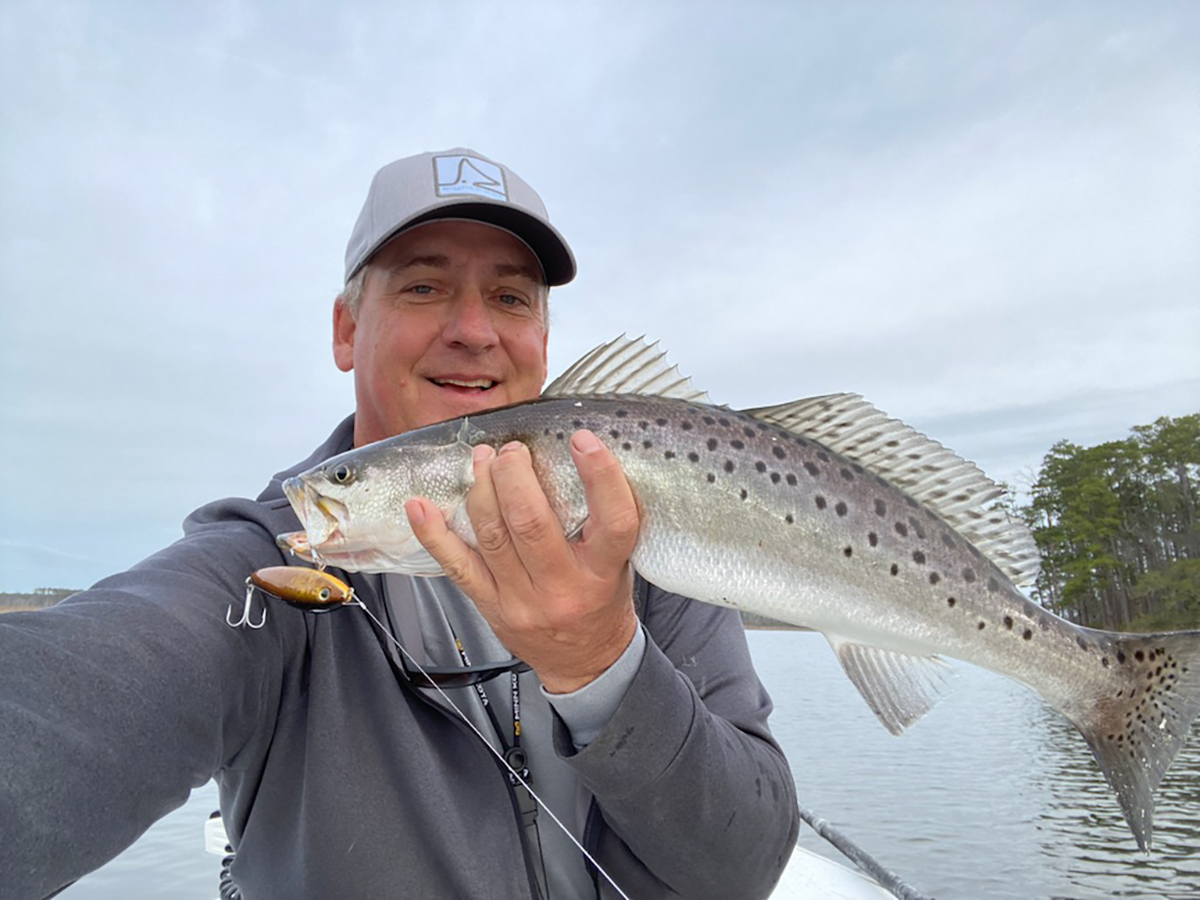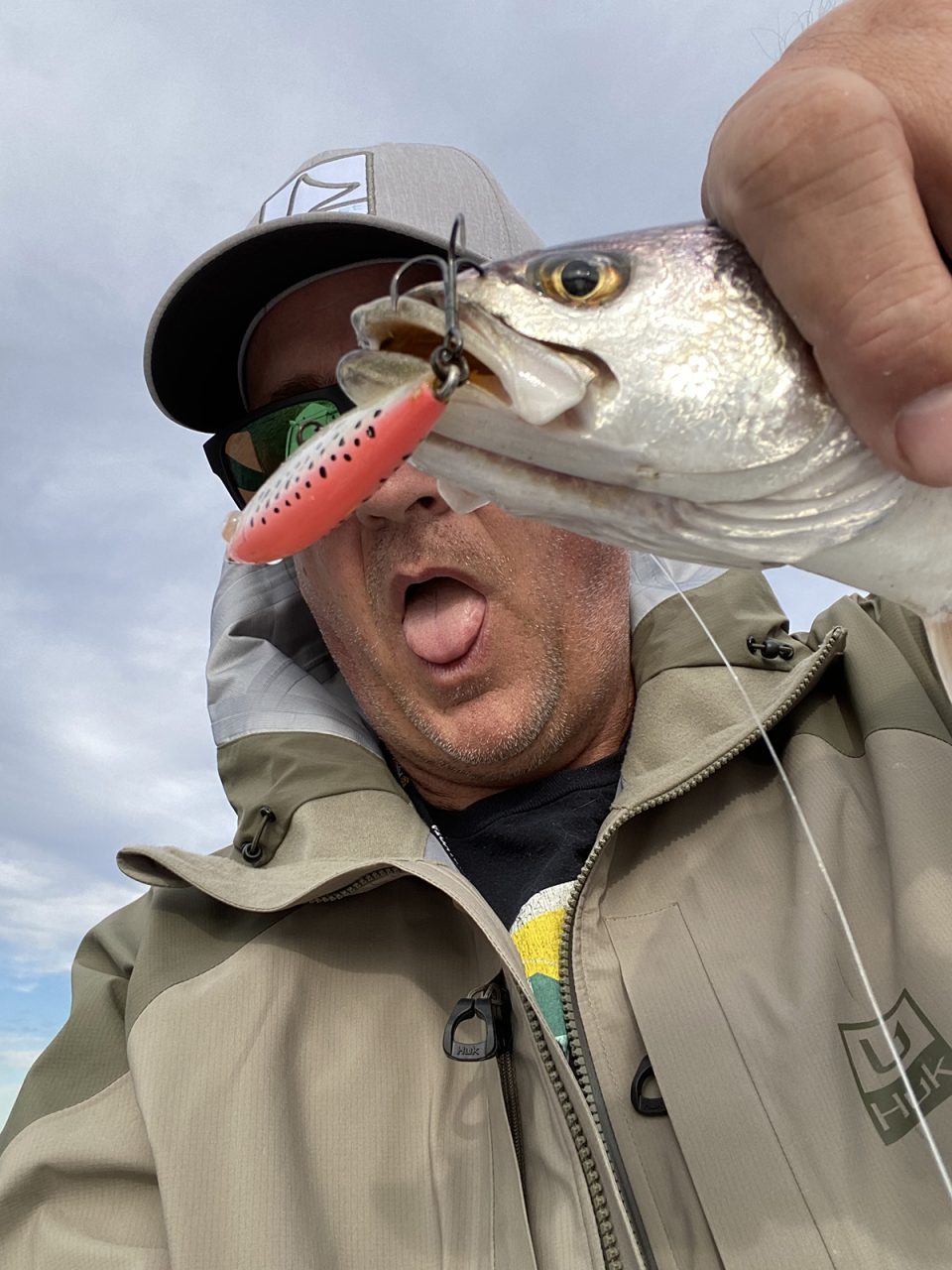
So, you’ve got your new rod, with a shiny, new reel spooled up with unblemished 10-pound braid and a gorgeous Mirrolure. Now what?
I’m assuming you have a boat. The great thing about speckled trout fishing is you don’t need an $80,000 boat with all the newest doo dads and bells and whistles. If you do have one of these Range Rovers of the water, that’s great too. Every little thing helps when finding fish, and the comfort of a nice boat makes a full day on the water more enjoyable. A small skiff with a trolling motor is enough to get started.
Supporter Spotlight
Launch the boat in a creek off a major river system, then head on down to a sheltered spot along the shore. In the spring we are looking for water that might be a little warmer than the surroundings. If there are trees, a high shoreline, some tall spartina grass, or even a marina, start there. Anything that will block the wind a little bit. These more sheltered areas are where trout will be in spring.
Related: March means the return of trout fishing in NC waters
Put your trolling motor down and set your speed so you are just barely making headway. This will allow you to cover all the area and also to move your plug effectively. If you have done any bass fishing this will be similar. What will be dissimilar however is that you aren’t casting to the bank all the time. Yes, make a cast to the bank just to make sure, but most of your casting will be parallel, or nearly so, to the shoreline.
Keep an eye out for any jumping minnows. When a trout grabs prey off the surface it makes a sound like a cork popping. Don’t be fooled by small mullet jumping for no apparent reason. They do it all the time. You will actually hear their tail splash as they go back down. It’s a pretty casual thing. But when being chased, they come out fast and scatter quickly. If the trout catches up, the pop sound will be how you know it was a successful pursuit. Quickly cast over to that spot.
It’s pretty wild really, but trout are super greedy. After they get a meal, they are quickly looking around for the next. If your lure happens to be the next thing they see, you will get a bite. You get your cast in front of that feeding trout and you start your retrieve, Twitch, twitch, pause, tap, set! You have to be right there on the tap.
Supporter Spotlight
A lot of new trout anglers are not aware of how soft this tap can be. When your lure pauses, they swim up to it, flare their gills, and it goes right in. Because there are not a lot of bigger predators in these creeks, they don’t have to immediately be moving to get away.
The big pull associated with pursuing a lot of other saltwater fish will not always be present. A lot of fish are missed due to guys not being ready. If you are, and you get that hook set, now you have to play the fish effectively. You can’t just haul them in like bass or redfish. The hooks will just pull out.
These fish shake their heads like crazy. You have to keep a tight line without treating it like a bull at a rodeo. I prefer to keep my rod bent to the side, especially on bigger fish. If they get their head out of the water and shake, well … you will most likely be sad afterwards as that 4-pounder slinks off.
When you finally get the big fish next to the boat, you are going to want to net it. Trying to hoist a trout bigger than 2 pounds over the gunwale is like watching a gymnast just barely land wrong on the balance beam and watching as she struggles to maintain balance but can’t quite get there. It’s not going to work.

Get a quality net, preferably the kind with the rubber mesh bag. That way your hooks don’t get all caught up and you can get the fish cleared out sooner, which becomes important if you are going to release the fish. My recommendation is to release trout over 20 inches long. If you get one of the big girls, get the hooks out, get your picture and lovingly set her free. The bigger fish make exponentially more eggs than smaller ones. If you get a 16- to 19-inch fish, let’s put it in the cooler for a fish fry. If your boat has a live well, then you can simply drop it in there and keep the fish alive all day and it will be the freshest it can be when you cook it that night. No live well? It’s best to have a good-sized cooler and have it full of ice, enough to submerge the fish in it completely.
Kill the fish quickly. Before you put it on ice, drive a knife blade quickly and firmly into the top of the head and into the brain. You know you’ve done it when the fish shakes quickly in your hand. Do this before putting the fish in the box. If keeping fish in a live well, do this before filleting. There is research out there that suggests that this keeps lactic acid from being produced and going into the muscle and makes for a fresher tasting meal. It is also more humane than letting fish thrash around in a box and suffocating.

Try something different
After working the shoreline for a while, you get a few bites, but you’re sure there are more fish there. Nothing wrong with going back and working the same stretch again. You most likely didn’t catch them all. Change color, retrieve speed, or lures. Here is where a switch to a light jig with a swim shad tail can get a few more bites.
Remember that the spring fish aren’t schooling up but multiple fish will use the same area. I prefer a hopping retrieve for these inshore creeks. The bottom can be soft and can foul the hook of a jig that’s dragging bottom. A quick lift will bounce it off the bottom and get their attention. They will hit it on the fall. Again, the tap is the thing. There will be no aggressive strike. Set the hook quickly on the slightest feeling of anything different.

Tides and Current
Tide will affect the fish and fishing differently. Some creeks will not have much tidal movement. In these waterways light lures and tactics are the way to go. The small Mirrodines don’t have much weight in them and hang in the water and look like an easy target. Light jigs can target fish in the whole water column. Fish will be distributed in a horizontal fashion, along a series of shorelines. The key is to find where in the creek they are concentrated on the day you are fishing.
In creeks with more tide, things will be different. The fish may congregate more specifically into holes to escape the current and provide a good ambush point as prey species who can’t swim as well against it are moved along. In these creeks, the small, lightly weighted plugs may not be very effective. They will get swept away too fast. There is a solution however. There is a weighted version called the Heavy Dine. These work well in stronger current situations.
Of course, a jig is a great option. This situation where fish are holding in a deeper spot in a current flow is what a jig excels at all over the world.
In creeks with lots of current, the places that are holding fish may also be more obvious. Bends will have deeper water on the outside. Long, straight stretches will be deeper on one side than the other. Often the water in these tidal creeks will be quite clear in the spring. In some you may be able to see the fish. The problem with that is that trout are very particular about being looked at. By the time you see them they have most likely seen you. Clear water demands long accurate casts.
If the water has strong current and is darker colored, a depth finder may be needed. Bay boats with depth finders and side finders really come into their own in this situation. The electronics help define where in the creek the deeper water is and may actually even help see a fish. However, remember that we are talking about water that is not very deep. Surveying the depths of the creek may be helpful for future, but it may spook the fish today. However, some of these small creeks with fast currents will also be good places later in the year. Put all you learn into your memory banks.
Some creeks will be better on an incoming tide. It’s often a good place to start. Trout normally like to feed when clean water is coming in with the tide. They feel more secure with a higher roof over their heads as well.
If you are fishing a creek with strong tidal flow for the first time, start with the incoming tide, and generally the last four hours of the rise may better. Of course, to every rule there is an exception. Fishing is filled with contradictions. There are some spots that the trout simply bite better on the incoming and others on the outgoing.
Honestly, there is no way for me to determine in advance which it will be in your chosen location. This is one of those times you just have to get out there.








